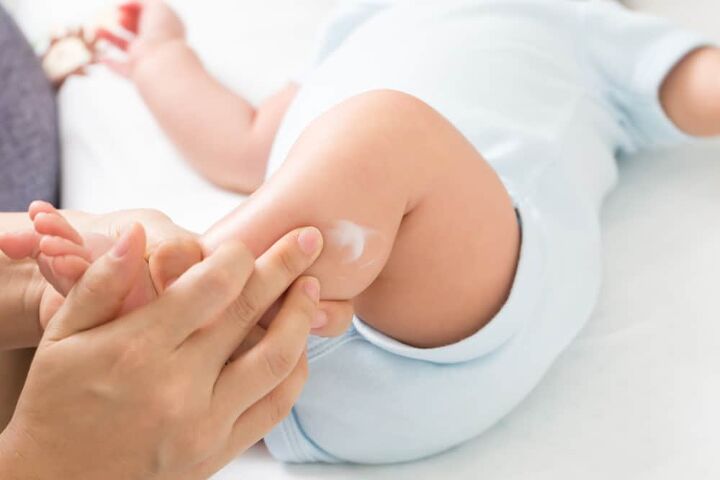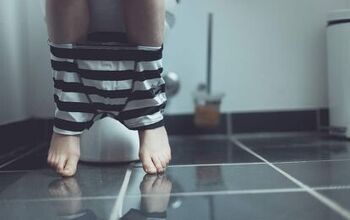How To Get Desitin Out Of Clothes (4 Ways To Do It!)

Desitin is one of those creams that are amazing for a wide variety of problems, especially in children and babies. However, due to its ointment-based state, it easily leaks onto clothing. You may have noticed that simply throwing the clothing in the washer doesn’t help. So, how do you remove Desitin that’s stuck on your clothing or someone else’s clothing?
Unfortunately, Desitin has an oily consistency that can stain fabrics. While it can be a bit tricky and time-consuming, Desitin stains can be removed using a number of methods. Among other common, effective techniques, degreasing products such as Solv-It and CitraSolv, as well as rubbing alcohol, and Goo Gone have been proven effective at removing Desitin stains.
In this article, we will cover several ways you remove Desitin from clothing. Also, we will give you step-by-step instructions to do this correctly the first time around. As long as you act quickly, you can remove the product reasonably easily and prevent a stain from occurring.
Why Does Desitin Stain?
Desitin is a multi-purpose ointment that can be used for treating minor cuts, burns, and scrapes, but is primarily used to relieve and prevent diaper rash. The active ingredient in Desitin is zinc oxide and although it effectively heals chaffed skin, the oily consistency is known to leave stains on clothing.
Fortunately, when you or baby’s clothes get stained by Desitin, it doesn’t mean you have to completely toss them out. When armed with the proper techniques, you can successfully get rid of the stain.
Four Methods For Removing Desitin From Clothing
Before we go through all the methods of removing Desitin from clothing, there are some things you’ll want to do to increase the chances of removal. First of all, you’ll want to wipe up as much of the cream as you can. You can use rags or paper towels to do this. Baby wipes are great, too, but only after you’ve gotten the majority of it out of the clothing.
However, try to avoid rubbing too much as this can cause the ointment to get pushed deeper into the fabric. Then, follow these additional steps to prep the clothing for Desitin stain removal:
- Pour a strong liquid detergent onto the affected area. Try to opt for a detergent that claims it can effectively cut through grease.
- Let the liquid detergent sit on the fabric for at least 30 minutes.
- Then, pour hot water onto the affected area. Or, consult the fabric care instructions and use the warmest water recommended.
- Scrub the detergent until it forms a lather and then continue scrubbing with a tough toothbrush or scrub brush to further penetrate the fabric.
- Allow the clothing to continue soaking in the hot water/ liquid detergent mixture for about two hours.
- When the two hours is up, launder the clothing as normal in your washing machine. If possible, use your machine’s longest pre-soak option.
- Dry as per usual.
As soon as the fabric has been washed, dried, and the cream has been removed, leaving only the stain behind, it’s time to use your stain-removal products. This will help to complete the job of ensuring every drop of Desitin is gone, and it will help to prevent the stain from becoming permanent.
1. Degreasers
Almost all diaper creams create grease stains, and these stains need to be removed with a product that can dissolve the oils that bury themselves into the fabric. You can always start by trying a good-quality dish-soap, such as Dawn, but diaper cream grease stains are often heavy-duty and tough to remove. It’s unlikely that dish soap alone will be adequate for the task. This is where degreasing products such as De-Solv-It or CitraSolv come in handy.
A caveat on the use of these or other degreasers if you have a HE washer: These machines have a low-water sitch, and as a result, the odor of products such as Lestoil can remain even when you have run a wash cycle. You have two choices in how you deal with this; you can either choose an alternative product or use a small amount of Dr. Bronner’s. This will help counteract and neutralize the powerful odor of stain-removing degreasing products.
Instructions
- Apply the degreaser. As soon as you have cleaned all of the Desitin off of the area, use a degreaser to remove the remaining ointment. Make sure you work it into the fabric by gently rubbing the product over the affected area.
- Let it sit. Let the degreaser sit on the Desitin for about 5 to 10 minutes. This will give it time to work its magic.
- Rinse the area. Using cold water, rinse the affected area before tossing the garment into the laundry as usual. You don’t want to use hot water, causing the oils to seep more in-depth into the fabric.
2. Goo Gone
Goo Gone is a wonderful product to use for Desitin stains as well. Goo Gone in itself is like a degreaser, but it’s used on all types of surfaces, from clothing to windows and cars. The product will work by absorbing the cream and removing it from the fabric. It works much like a degreaser because it prevents the sticking mechanism of individual elements, allowing you to remove whatever it is you need to remove.
Instructions
- Apply the Goo Gone. Using your finger or a spoon, apply the Goo Gone to the Desitin on your clothing.
- Work the product. You will then want to rub the Goo Gone into the fabric and work it around the stain. This will help it get further into the fibers to deactivate the sticking mechanism of the cream or ointment.
- Rinse with hot water. Since Goo Gone is very sticky, you will need to rinse the area with some hot water to remove it from your fabric thoroughly. As the Goo Gone washes away, it will also take the cream with it.
- Wash your clothes. Immediately after the Goo Gone is removed, you will need to throw your article of clothing into the wash. After it goes through the full cycle of laundry, check to see if the Goo Gone did its job. If not, try using rubbing alcohol.
3. Rubbing Alcohol
If the kind of Desitin that has created the staining has zinc oxide as the main ingredient, this is fortunate because there is an easy and inexpensive way to deal with the situation. The solution is rubbing alcohol. You may already have some handy, but it can easily be purchased in spray bottles, if not.
Rubbing alcohol is almost miraculous as a stain removal product. If you don’t already have some in your store cupboard, you may want to think about buying a substantial quantity to save on cost. You can then transfer the amount you need at any given time into a spray bottle of your own.
Instructions
- Cover the stain. For washable fabrics, cover the stain with the rubbing alcohol, then spread it around the affected area.
- Rinse the area. Then, rub the fabric against itself under a stream of cold tap water.
- Reapply the alcohol. At this point, you can and pour on more alcohol onto the piece of clothing if you need it.
- Run the laundry. Toss the laundry in, and wait to see if the rubbing alcohol worked. If it did, then you will need to dry the garment.
- Allow it to line dry, preferably using the fresh air. Air drying is always preferable to remove any lingering odor from the wet items. Avoid using a dryer as the heat can cause the stain to ‘set.’ Better to take a more cautious approach and let the garments dry naturally.
4. White Vinegar
Distilled white vinegar is also useful as a remover of diaper cream stains. The method is different from that you’ll use with rubbing alcohol. Begin by working a small quantity of dish soap into the stain, using your fingers or an old toothbrush. Next, soak the item in a 50/50 solution of distilled white vinegar and cold tap water for around 30 minutes before placing in the washing machine for a normal wash cycle.
If it’s a very stubborn stain, you can leave the clothing to soak in a bucket of vinegar overnight. If you’re worried about removing the smell, you can toss 1/2 cup of baking soda into the washer when you wash this piece of clothing. The baking soda will eat away the odor of the vinegar.
Related Questions
How do you remove washed stains?
Soak the baked-in stains in distilled white vinegar. Next, make a paste using equal parts of vinegar and baking soda. If this is insufficient to dissolve the stain, add two tablespoons of white vinegar and laundry soap to a bucket of cold water. You will need to soak the items in this solution overnight before laundering as usual.
Can you use Goo Gone on clothes?
Can GooGone be used on clothing? The simple answer is yes, as long as you’re not wearing them at the time! Wash the clothes soon after application, using a generous amount of laundry detergent.
Can you use baking soda and vinegar on colored clothes?
If you need to launder a load of sportswear, which has a particularly strong odor, just place ½ a cup of baking soda and ½ a cup of distilled white vinegar in the fabric softener tray of the washing machine. Don’t add any detergent, and just run a regular wash cycle.
How do you remove Desitin from carpet?
If you managed to get Desitin cream on your carpet, you’ll want to act quickly before it bleaches your carpet or causes a significant stain. Scoop up as much of the cream as you can with a spoon and dry cloth, and then apply baking soda to the affected area.After 30 minutes, vacuum up the baking soda and use a clean cloth with lukewarm water and a gentle dish soap to dab the area. Rinse the cloth and wipe the area several times to remove all of the cream Finally, pat the carpet dry with a dry, clean white cloth and let it air dry completely.
Wrapping It Up
While it can be extremely frustrating to get Desitin on your clothing, it’s relatively easy to remove. By applying the correct method, you can release the oil-based cream’s grip, preventing it from staining your garment. If you’re using Desitin, covering the area with a gauze pad or an undershirt may help keep the product from getting onto your favorite articles of clothing. Nevertheless, as long as you act fast, you can remove the cream from your clothing pretty easily, saving you from the hassle of dealing with a stain later on.

Heather is a passionate writer who loves anything DIY. Growing up, she learned everything from home repairs to design, and wants to share her tips with you. When she's not writing, she's usually hiking or searching for her next DIY project.
More by Heather Robbins



























